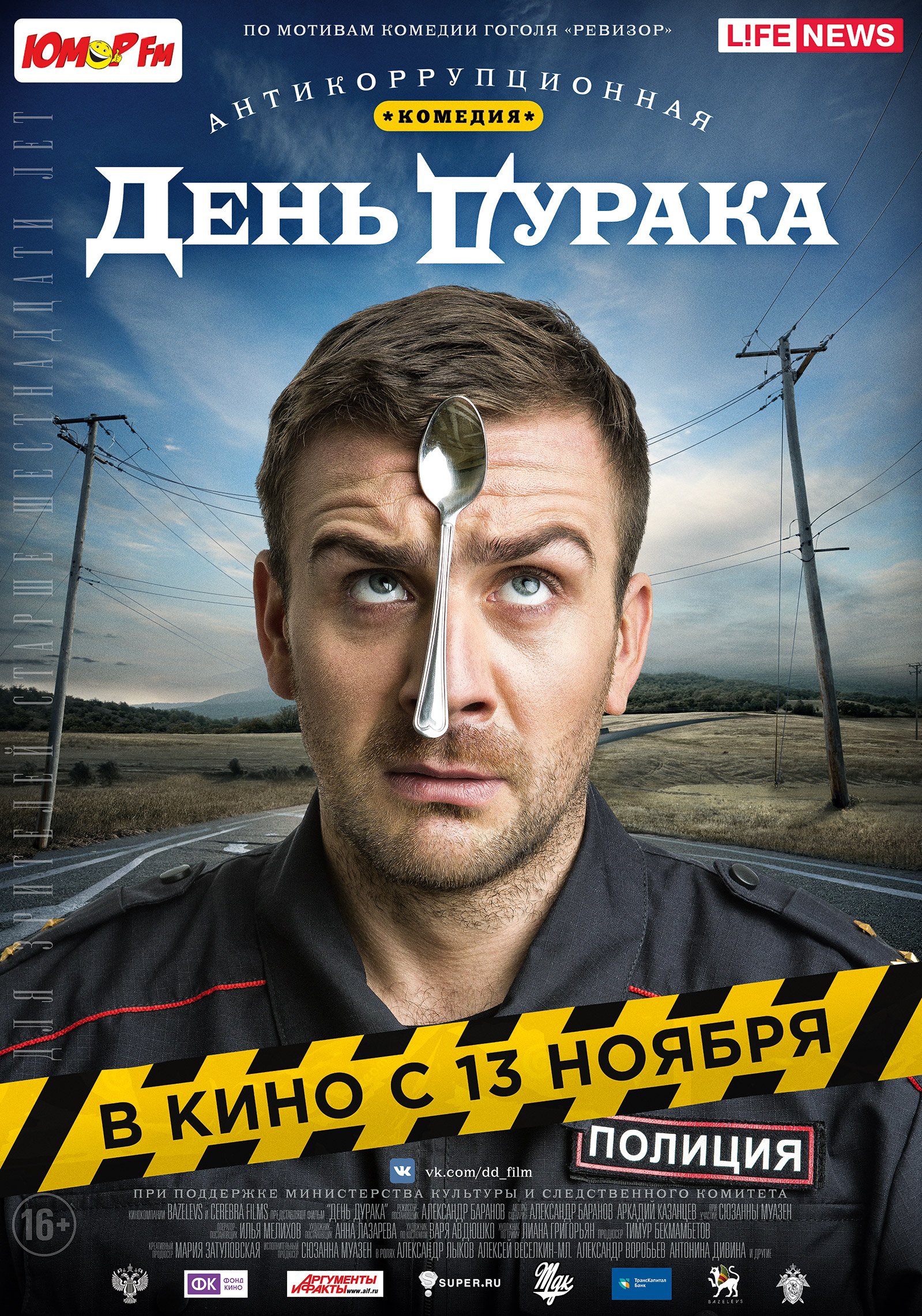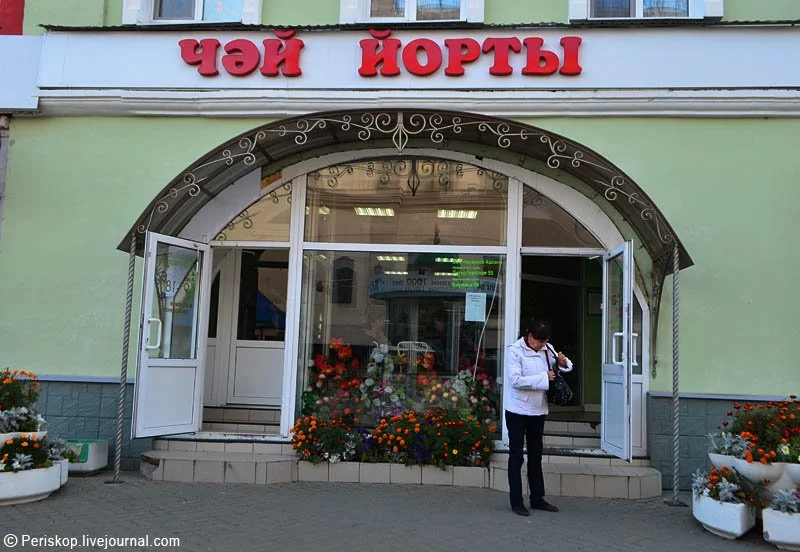Kazan is BOOMING!
I arrived at my airbnb room in Kazan, and, holy moley, look how big it is! (Ignore the exploding suitcase)
It was also quite near the center. So I rested a bit, washed off the shower from the night before and set out to explore. I stopped in at a Tatar restaurant, ate some food I didn’t recognize, and took this selfie:
I misunderestimated how tired I was, but I didn’t want to head home. Rather than get drunk (always an option here), I decided to go to the movies. I saw День Дурака, which means “Fool’s Day.” It was a modern reworking of Gogol’s “The Inspector General.”
It was….terrible! As you can probably tell from the poster. The spoon stuck to the forehead thing was one of its major jokes. But I still enjoyed trying to make sure I understood everything, but I *did* worry when I was the only one laughing in certain parts.
“Renat” (my guide) came to pick me up the next morning and we went straight out to the riverside to get a panoramic view of New Kazan. In the past ten years, Kazan has undergone a complete facelift. This view of tall, modern buildings and sports stadiums occupies what Renat said was marshland just five years ago.
Kazan has become a mecca for sports fans, what with its new soccer stadium (all ready for FIFA 2018!) and brand-new aquatics center. Older Kazan looks a lot like St. Petersburg. Here’s a photo I stole from someone else on the web:
So, in other words, it’s gorgeous. Plus, city planners put in some serious study time and have succeeded at decongesting the roads. Impressive and probably unprecedented for a 1000-year-old city.
Renat is Tatar, which makes sense. Kazan is the capital of Tatarstan, a republic inside Russia. He says about 48% of the city are Tatar. The Tatars are descendants from the original occupants of the land in the 8th century. At that time they were called Bolghars (some of them eventually moved on to what is today Bulgaria). Genghis Khan’s sons, the Golden Horde from Mongolia) came and conquered the Bolghars and mixed with them. So the Bolghars and the Bolghars mixed with Mongolians today make up what is known as the “Volga Tatars.” Some Tatars have more Mongolian features (darker skin, more Asian eyes), and then others retain the Bolghar look (which, near as I can tell, is just an Eastern European look).
It bothers Renat when Putin refers to all people in the country as Russian. This comes down to the two different words that mean Russian. The first word, “russkiy” means ethnically Russian. The second word, “rossiyski” means, “belonging to the Russian Federation.” I remember when I learned this distinction; it was when I was conducting experiments in St. Petersburg one year. I was paying the subjects and the payment form required people to write their addresses. I told people, “Oh, there’s no need for that, just write that you’re Russian.” Well, one woman said, “Ok, but I’m actually Jewish.” My brain did a couple of backflips before I figured it out.
So it makes sense that this would bother Renat; Russia is made up of many, many different ethnicities. The Volga Tatars speak Tatar, a Turkish language, and it was the language Renat spoke at home (he spoke Russian at school). Additionally, Tatars are Muslim. Renat, who is a secular Muslim, says that the Tatar version of Islam is very mild. I’m not sure if “mild” is the correct word to use to describe any religion, so I’ll just say that the Islam as practiced by the Volga Tatars is much closer to European traditions.
For example, Tatar women are only required to cover 1/3 of their head. The traditional clothing looks like this:
But no one actually dresses like this. In practice, it is difficult to wear a hat that only covers a third of your head– it keeps falling off. So Renat said that most Tatar women today wear scarves. At this time of the year, when everyone is bundled up, it’s difficult to tell Tatars from non-Tatars. But I did spot two Tatar women inside. They were very glamorous, wearing furs and jewelry and a good deal of make-up. One woman had her scarf tied up on top of her head like a turban; the other woman had her scarf tied at the nape of her neck.
Also, the first Imam of Kazan changed the rules from praying five times a day to only praying four times a day. His reasoning was that it gets darker in Kazan a lot earlier than it does in Saudi Arabia, so it makes sense to only have four prayers. Another difference is that, while Muslims are required to visit Mecca (make the haj), if it’s too difficult, Volga Tatars can go to the city of Bolgar instead.
Kazan has a Kremlin, but unlike the one in Moscow, this one has a mosque. It was built recently and is very grand. Renat says this is more like a museum to Islam, not a real working mosque. It’s really only used for prayers a few times a year.
The ceiling is magnificent:
The rest of the Kremlin is very similar to the one in Moscow. For example, here is the building where the President of Tatarstan works:
The tower on the left has an interesting legend. Supposedly a beautiful princess from Kazan was so beautiful that the light never shined here (because her beauty was so bright) and her voice was so beautiful that there were no birds for hundreds of miles. Ivan the Terrible met her and wanted her to become his wife. She refused. He was so enraged that he threatened to level all of Kazan and the surrounding lands. Fearing for her people, she relented and agreed to marry Ivan, but only if he built her a tower. He sent his men to work immediately and that tower was built in seven days. She then climbed to the top of the tower and threw herself down.
Well, Renat says it’s an interesting tale, but not the truth. He then went on to describe the true story to me which was both much more believable and much more confusing. The fable is much easier to remember.
We then went to lunch at this tea house. Russian speakers will notice how odd it is to see Tatar words written in Cyrillic. Most things here in Kazan are written in both Russian and Tatar:
I started the meal with Elesh, a round meat pie served with clear broth.
Renat had triangular-shaped pies. There’s kind of an ethnic tension in the names of the pies. In Tatar they are called upochmak. In Russian they are called триугольники, which just means “triangles.” This restaurant took the clever way out and just drew triangles on the menu.
For dessert we had the most traditional Tatar sweet, chak chak. Chak chak is essentially little tubes of funnel cake doused in hot honey and then cooled into a solid shape. From a distance they look like rice krispie treats.
I’ve come to believe that nearly every culture has some version of fried dough– OF COURSE. Because it’s so freakin’ delicious. The honey really added a nice touch to this version.
Over lunch Renat asked why I was on my trip. I explained about my mid-life crisis. Renat then said he had gone through a crisis about four years ago when he and his wife got divorced. He moved to Moscow and worked construction for a while. But then they reconciled somehow so now they’re back together and have three daughters. In addition to being a tour guide he also has a glass molding business, for example, the kind that makes little bottles. Meanwhile he’s also building up his dacha and spent the day dodging calls from a man named Vasily who wanted to drop off a load of soil that Renat will use to level out his yard.
Later I stumbled upon the Museum of Socialist Everyday Life. It’s like a Russian closet from 1980 exploded: old toothbrushes, tea, records, perfumes and cosmetics, toys, clothing, magazines…
They had a special exhibit dedicated to jeans, which makes sense. During Soviet times Russians were bananas for jeans but you couldn’t get them anywhere. This exhibit includes signed jeans from some of Russia’s most popular musical artists.
On the day I visited schoolchildren were there on a tour and a man was explaining some of the peculiar objects to them. For example, he showed them a goat costume, complete with plastic hooves. “Would any of you like to dress up as a goat?” he asked. “Nooooooo!!!!” the children gleefully yelled. His next item was a mystery and he doled out clues one by one: it protects you but it’s a little dangerous, it’s electric, you plug it in. I’ll see if you can guess. This is it:
And I’m sure you guessed correctly. It’s an electric mousetrap. <shiver>
Here are some Soviet condoms.
And some perfumes. The cologne called “Sasha” on the right, with the 80’s Soviet man looks intriguing.
This was my favorite literary find. A textbook.
The title reads: Modern Bourgeois Criminology




















